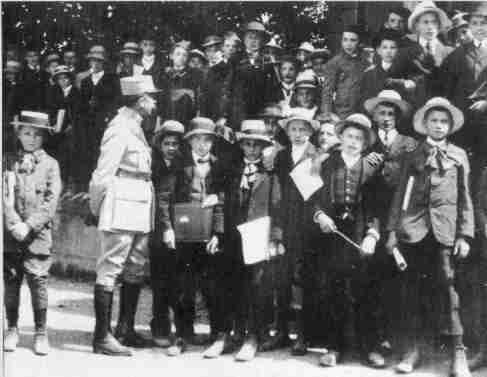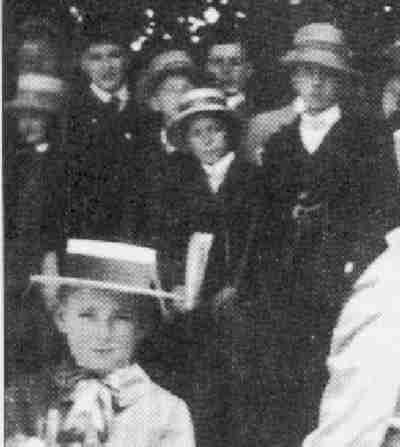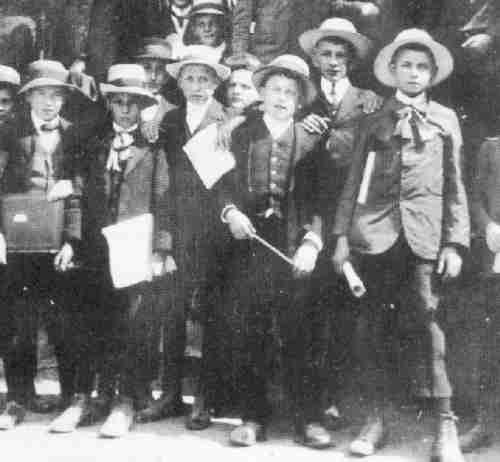
Figure 1.--I believe these French boys are celebrating because they just received their school certificates. I believe the photograph was taken in Alsace about 1920. Note the rakish way in which some boys have adjusted the brims of their hats.

HBC is attempting to assess French schoolwear trends. We have assembled a good deal of information on different types of garments, but an accurate assessment of trends over time and conventions remains elusive. Thus HBC is assembling images of invidual schools. One a number of schools have been assesmbled it will enable us to better understand trends over time and accepted conventions. Unfortunately often little information is available on the schools pictured in many available images. HBC will do its best to assess these images. Hopefully our French consultants will be able to add additional details.
Pressumably these boys all went to state elementary schools. I'm not sure that private schoolboys would have been imcouraged to mix freely with boys attending state schools. The source identifies the children as from the écoles d'Alssace.
I'm not positive about the date of this undated photograph. I had speculated that it was taken about 1915. The identification in Alsace, however, suggests that it was taken after World War I (1914-18) as Alscae was German from 1871-1918, thus this picture was apparently taken about 1920. The clothing styles suggest it was taken before the mid-1920s.
The boys children in this photograph have apparently celebrating because they have just received their school cetificate (Certificat D'Etudes Primaires). Apparently there was a parade and some kind of city-wide celebration for the boys. Apparently the event was an important celebration in France of the Third Republic, one source calls it a "véritable rite républicain".
I believe that the boys received this when they graduated from elementary school. So the boys here are probably boys who have just graduated from their elementary school. They may not hace all been from the same class, but presumably a lot of the boys standing together are with their classmates. The boys look to be about 12 or 13 years old.
There appear to be some older boys in the crowd. I'm not sure why this was. There is no way of knowing which boys are actually receiving their school certificates, except for the ones actually holding the certificates.
No teachers are in the photograph.

Figure 4.--Only one boy in the group wears a boater. He also wears a floppy bow.. |
The boys in this photograph are all wearing suits. Presumably many of these boys wore smocks in school. They no doubt got dressed up in their best suits to celebrate receiving their school certificates.
The boys wear a wide variety of headwear. This photograph is notable for the variety of hat styles. There is, however, one dominate style. Most appear to be wearing white hats, rather like sailor hats with the brims turned down. Noticed how some of the boys have adjusted the brims in a stylish manner. Some of the boys wear their hats without adjusting the brims. Some of the boys, however, have clearly given some thought to style and how to look fashionable.
Several other hat styles can be seen in the photograph. There are many other styles visible. One boys wears a flat crown straw hat which the British called a "boater".
Note the one boy in the back wearing a campaign or garrison cap. He is the only boy wearing one. Perhaps the other boys, or their parents, didn't think it was appropriate for dress wear. This helps date the image to the 1910s, perhaps during World War I (1914-18).
All the boys are wearing hats rather than any informal cap styles. Notable for its absence is the beret. HBC believes taht schoolboys commonly wore berets in the 1900s and 1910s. However, they were probably not considered a formal dressy style. Thus the boys wore their best hats for the celebration.
It is unlikely that these boys actually wore these caps to school. More likely these are their formal hats only worn for dressing up. They would get thrashed around a good bit at school. More likely for schools they would have worn less formal caps or berets.
None of these boys wear smocks. Presumably because of the military styling of the uniforms, the school would not want them covered up with a smock. At other French schools, however, boys of this age would commonly wear smocks.
The photograph is not clear enough fior a close examinatiion of collars. The photograph is notable for what is not seen as much as for what is seen. Noticeably lacking are large ruffled collars. A few years eralier and some of the boys this age would hace worn large white ruffled collars. Also there are no Eton collars being won. One boy weara an adult looking rounded collar.

Figure 5.--The boys appear to wear mostly kneepants, although the image is a little unclear. Also notice the heavy boots. |
A few of the boys wear floppy bows, but they are a minority. Other boys appear to wear stocks or cravats. I only see a few modern-looking ties. Some boys do not have any neck wear.
Nearly all of the boys are wearing suit jackets. Only one boy at the back wears an informal jacket. Note that noe of the boys are in shirt sleeves. This does not appear to have been because it was cold. It does not appear to have been a chilly day. Rather the boys are wearing their jackets because it was a formal occasion and they wanted to dress up. Some of the jackets button nrar the neck, but most have lapels and button in a modern style near the end of the laels.
Some of the boys are wearing vests. As most boys have their jackets buttoned up, it is not possible to tell how common vests are. Howevr as all the boys with open jackets have vests, they were likely quite common.
The image does not show clearly what kind of pants the boys were wearing. The boys that do show what kind of pants they are wearing appear to mostly be wearing kneepants. One boy, however, wears very long pants. I'm not surre if they are long kneepants or long pants that he has outgrown.
The boys in kneepants all appear to be wearing long stockings. I don't see any boys with short socks. That is interesting because I notice that short socks are quite common in contemporary magazines illustrating fashions and in post cards showing formally dressed children.
It is difficult to tell precisely from this image, but the boys appear to be mostly wearing heavy shoes or boots. Only one boy appears to be wearing fashionable footwear. None of the boys wear sandals.
Akk of the boys wear similar length hair styles. None wear hair over their ears, but none have especially short cuts.
Related Chronolgy Pages in the Boys' Historical Web Site
[Main Chronology Page]
[The 1840s]
[The 1850s]
[The 1860s]
[The 1870s]
[The 1880s]
[The 1890s]
[The 1900s]
[The 1910s]
[The 1920s]
[The 1930s]
[The 1940s]
[The 1950s]
Related Style Pages in the Boys' Historical Web Site
[Return to the Main French individual school page]
[Return to the Main French school page]
[Main school uniform page]
[Main country page]
[Smocks]
[Berets]
[Knee pants suits]
[Short pants suits]
[Stockings]
[Eton suits]
[Jacket and trousers]
[Blazer]
[School sandals]
